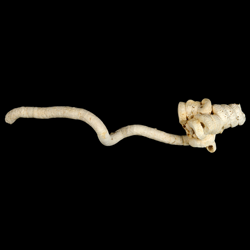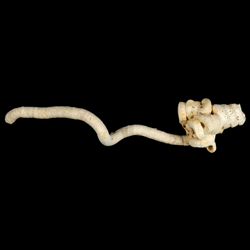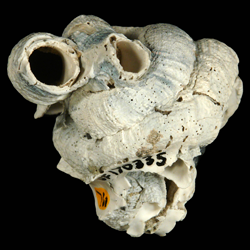
Vermetidae

- Phylum: Mollusca
- Class: Gastropoda
- Order: Littorinimorpha
- Family: Vermitidae
Overview
Common name: Worm snails
Key morphological features: The Vermetidae have shells that range from regular to highly irregularly coiled. They are permanently attached to hard substrates and form cemented, often uncoiled, tubes that closely resemble those of serpulid worms. Some species form dense, cemented, aggregations of many individuals resembling a ball of tangled string. Vermetidae can be distinguished from serpulid worms by their three-layered shell structure (serpulid tubes have a two-layered shell structure) and the presence of a protoconch. Some vermetids also have one to three internal septa or a long slit at the aperture. Source: Davies, A.M. 1971. Tertiary Faunas Vol. 1, second edition. New York: American Elsevier Publishing Company, Inc. 571 pp.; Tunnell Jr., J.W., Andrews, J., Barrera, N.C., Moretzsohn, F. 2010. Encyclopedia of Texas Seashells. College Station: Texas A&M University Press. 512 pp.
Geological range: Triassic to Recent (Davies, 1971).
Geographic distribution: A distributional map for modern Vermetidae may be accessed from OBIS. A distributional map for ancient Vermetidae may be accessed from the Paleobiology Database.
Diversity: There are 135 recognized living species of Vermetidae and 16 genera (WoRMS database, unvetted). The Paleobiology Database recognizes 11 fossil genera and 114 fossil species of Vermetidae (unvetted)
Paleoecology: The Vermetidae are sessile suspension feeders that live permanently attached to hard substrates in subtidal warm water habitats. Suspension feeding is accomplished in some species by deploying a mucus net that individuals use to capture and “reel in” food particles from the water column and surrounding substrate (e.g., Hughes & Lewis, 1974). Some species cement to each other in dense, tangled aggregations and are capable of forming reef structures (e.g., Schiaparelli et al., 2006). They are distributed worldwide in shallow subtropical and tropical waters.
Phylogenetic status: Unknown.


